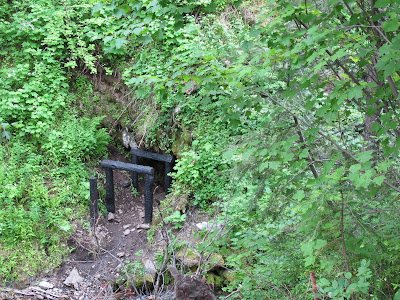It’s also drying out, which now puts the fire danger from low to moderate. Yes, fire is something that is always on people’s minds out here. This year especially so as the forest service is hosting several activities commemorating the centennial of the 1910 Big Blow Up, or the "Year When the Mountains Roared."
Driven by hurricane-force winds, the Great 1910 Fire - the largest in U.S. history - incinerated more than two million acres of timberland in northern Idaho and western Montana in two terrifying days and nights. The fire storm destroyed several towns but miraculously, the death toll was limited to about 133 people.
Rather than let the loss be a total defeat, the strongly environmentally conscious President Teddy Roosevelt and the U.S. Forest Service used the hard learned lessons to strengthen the fledgling Forest Service (created just five years previous) and the National Forest System.
One of the more compelling stories from this fire is that of Ed Pulaski (a name familiar to fellow Miami Valley Outdoor Club members who have worked trail maintenance at Wildcat Hollow).
Pulaski, an Ohio native born in Greensprings, was a ranger supervising crews about five miles south of Wallace, Idaho, when the fire suddenly overwhelmed his crew in a narrow steep creek drainage. Drawing on his knowledge of the area and the dynamics of forest fires, Pulaski led his men to safety in an abandoned prospect mine that had seepage from a spring. But despite his effort to hold back the flames and smoke with hatfulls of water and wet blankets across the entrance, several supporting timbers caught fire. When one man panicked and tried to flee the mine, Pulaski pulled a gun and threatened to shoot whoever tried to leave. The men survived by lying prone on the tunnel floor, where they all became unconscious. When it was all over, five men and two horses died, but the remaining men, including Pulaski, suffered life long effects of the fire . Pulaski was blind for several months afterwards.
Today, the mine entrance, now known as the Pulaski Tunnel, is listed on the National Register of Historic Places and includes a 2-mile interpretive trail leading up to the actual mine. In hiking the trail, Jim and I got a sense of how confined the men were in the narrow and steep terrain.
Just one year after the fire, Pulaski developed the Pulaski Tool, a basic implement of not only fire control but also a tool that club members use for trail work. Little did we know that every time one of us hefted the Pulaski at Wildcat Hollow, we were in one sense part of the story of "the Great Blow Up"!
Other trips we've taken on our days off include a 3-day getaway to Cook City, Montana, driving over the Beartooth Pass (whose elevation tops out at 10,974 feet) and into Yellowstone National Park, along with some day hikes in the Bitterroots.
We are looking forward to David flying in tonight. We will be leaving for Glacier National Park tomorrow for a few days. Grateful and thankful that life is good right now. More later!
The Pulaski Tunnel where 45 men retreated in the 1910 Great Burn

Pulaski Tool

Traces of old mining activity along the Pulaski Tunnel Trail

Scenes from top of Beartooth Pass


A scene along Big Creek in the Bitterroots






Your pix are beautiful! Enjoy being with your boy and especially enjoy Glacier together. I have very fond memories of the Siyeh Bend trail there, even if I did blow out both knees! ENJOY!!!
ReplyDeleteHi Connie - I enjoy reading your blog. What a life you have!!!
ReplyDelete